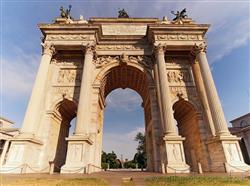|
Arch of Peace
|
|
|
Show an other treasure of art and history in Milan:
|
 Mostly represented styles: Neoclassic Mostly represented styles: Neoclassic
The Arc of Peace is located at the beginning of Sempione Avenue, on the line joining Sempione Avenue with Dante street passing through the center of the Sforza Castle and the Sempione Park. It is positioned in the center of a large circular square, between the two tollhouses of the ancient Sempione gate of the city.
The history of the Ark of Peace begins with the construction of the Arch of Amelia, erected in January 1806 on the design of the Marquis Cagnola as a temporary building to celebrate the arrival in Milan of the newlyweds Eugene of Beauharnais, viceroy of Italy, and Augusta Amalia of Bavaria, who had married on January 13th. This arc had however been built within the Public Gardens ("Giardini Pubblici") and was ephemeral, as it was built in papier-mache.
Given the success that that arc had had also among foreign visitors, the Council of Milan, the municipality of the time, decided to build a larger, more durable one, in a more appropriate position.
The new arc, also designed by Cagnola, was conceived as "the Arc of Victory", to celebrate the French victory in the Battle of Jena, and was built starting from the autumn of 1807. A great six horses chariot at the apex had to symbolize the Napoleonic victories.
The area on which it was to be erected was chosen in the middle of the north-west side of the at that time Squad of Arms that was behind the Sforza Castle, the area that was then transformed into the Sempione Park.
Waterloo surprised the Cagnola by two-thirds of the work.
The new emperor, Ferdinand, Austrian however, ordered the work to be completed and he even came to Milan in 1838 to inaugurate the completed arc.
Few modifications had had been necessary to change the meaning of statues and bas-reliefs, in particular because all figures were unrecognizable, being represented with togas, in the manner of ancient Romans. In particular, the sword in the hands of the girl on the six horses chariot (work of the sculptor Abbondio Sangiorgio) was removed (being it the symbol of the Napoleonic victories) and replaced by frondes, symbol of the Habsburg peace. The arc, already Arch of Amalia, Arch of the Simplon and Arc of Victory, had thus become the Arc of Peace!
Under the Arc of Peace passed on horseback, celebrated by the crowd, Vittorio Emanuele II and Napoleon III on June 8, 1859, four days after Magenta's victory.
The Arch of Peace is enriched by the presence of numerous statues and bas-reliefs. Bas-reliefs include, among others, the Battle of Leipzig, the Foundation of the Lombardy-Veneto Kingdom, the Vienna Congress.
Among the statues there are the allegories of the rivers Po, Ticino, Adige and Tagliamento and the representations of various pagan gods.
If you are interested in a guided tour of this monument send an email!
Categories: Others
Piazza Sempione, 20154 Milano MI |
Further pictures of the Arch of Peace in the section Photography |